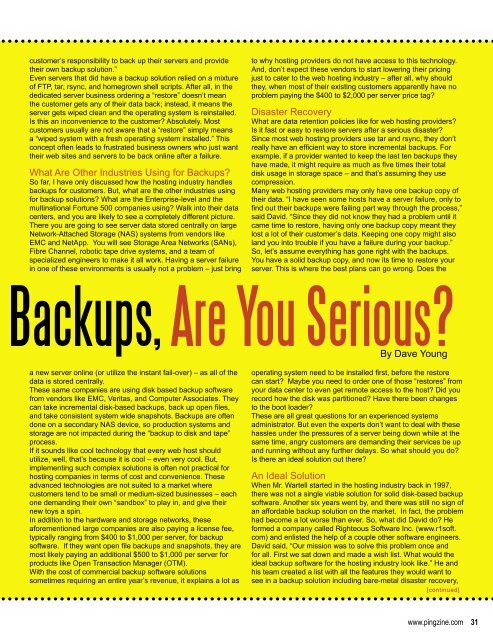Ping! Zine Magazine - Zine Web Tech Magazine
Ping! Zine Magazine - Zine Web Tech Magazine
Ping! Zine Magazine - Zine Web Tech Magazine
Create successful ePaper yourself
Turn your PDF publications into a flip-book with our unique Google optimized e-Paper software.
customer’s responsibility to back up their servers and providetheir own backup solution.”Even servers that did have a backup solution relied on a mixtureof FTP, tar, rsync, and homegrown shell scripts. After all, in thededicated server business ordering a “restore” doesn’t meanthe customer gets any of their data back; instead, it means theserver gets wiped clean and the operating system is reinstalled.Is this an inconvenience to the customer? Absolutely. Mostcustomers usually are not aware that a “restore” simply meansa “wiped system with a fresh operating system installed.” Thisconcept often leads to frustrated business owners who just wanttheir web sites and servers to be back online after a failure.What Are Other Industries Using for Backups?So far, I have only discussed how the hosting industry handlesbackups for customers. But, what are the other industries usingfor backup solutions? What are the Enterprise-level and themultinational Fortune 500 companies using? Walk into their datacenters, and you are likely to see a completely different picture.There you are going to see server data stored centrally on largeNetwork-Attached Storage (NAS) systems from vendors likeEMC and NetApp. You will see Storage Area Networks (SANs),Fibre Channel, robotic tape drive systems, and a team ofspecialized engineers to make it all work. Having a server failurein one of these environments is usually not a problem – just bringto why hosting providers do not have access to this technology.And, don’t expect these vendors to start lowering their pricingjust to cater to the web hosting industry – after all, why shouldthey, when most of their existing customers apparently have noproblem paying the $400 to $2,000 per server price tag?Disaster RecoveryWhat are data retention policies like for web hosting providers?Is it fast or easy to restore servers after a serious disaster?Since most web hosting providers use tar and rsync, they don’treally have an efficient way to store incremental backups. Forexample, if a provider wanted to keep the last ten backups theyhave made, it might require as much as five times their totaldisk usage in storage space – and that’s assuming they usecompression.Many web hosting providers may only have one backup copy oftheir data. “I have seen some hosts have a server failure, only tofind out their backups were failing part way through the process,”said David. “Since they did not know they had a problem until itcame time to restore, having only one backup copy meant theylost a lot of their customer’s data. Keeping one copy might alsoland you into trouble if you have a failure during your backup.”So, let’s assume everything has gone right with the backups.You have a solid backup copy, and now its time to restore yourserver. This is where the best plans can go wrong. Does theBackups, Are You Serious?By Dave Younga new server online (or utilize the instant fail-over) – as all of thedata is stored centrally.These same companies are using disk based backup softwarefrom vendors like EMC, Veritas, and Computer Associates. Theycan take incremental disk-based backups, back up open files,and take consistent system wide snapshots. Backups are oftendone on a secondary NAS device, so production systems andstorage are not impacted during the “backup to disk and tape”process.If it sounds like cool technology that every web host shouldutilize, well, that’s because it is cool – even very cool. But,implementing such complex solutions is often not practical forhosting companies in terms of cost and convenience. Theseadvanced technologies are not suited to a market wherecustomers tend to be small or medium-sized businesses – eachone demanding their own “sandbox” to play in, and give theirnew toys a spin.In addition to the hardware and storage networks, theseaforementioned large companies are also paying a license fee,typically ranging from $400 to $1,000 per server, for backupsoftware. If they want open file backups and snapshots, they aremost likely paying an additional $500 to $1,000 per server forproducts like Open Transaction Manager (OTM).With the cost of commercial backup software solutionssometimes requiring an entire year’s revenue, it explains a lot asoperating system need to be installed first, before the restorecan start? Maybe you need to order one of those “restores” fromyour data center to even get remote access to the host? Did yourecord how the disk was partitioned? Have there been changesto the boot loader?These are all great questions for an experienced systemsadministrator. But even the experts don’t want to deal with thesehassles under the pressures of a server being down while at thesame time, angry customers are demanding their services be upand running without any further delays. So what should you do?Is there an ideal solution out there?An Ideal SolutionWhen Mr. Wartell started in the hosting industry back in 1997,there was not a single viable solution for solid disk-based backupsoftware. Another six years went by, and there was still no sign ofan affordable backup solution on the market. In fact, the problemhad become a lot worse than ever. So, what did David do? Heformed a company called Righteous Software Inc. (www.r1soft.com) and enlisted the help of a couple other software engineers.David said, “Our mission was to solve this problem once andfor all. First we sat down and made a wish list. What would theideal backup software for the hosting industry look like.” He andhis team created a list with all the features they would want tosee in a backup solution including bare-metal disaster recovery,[continued]www.pingzine.com 31
















